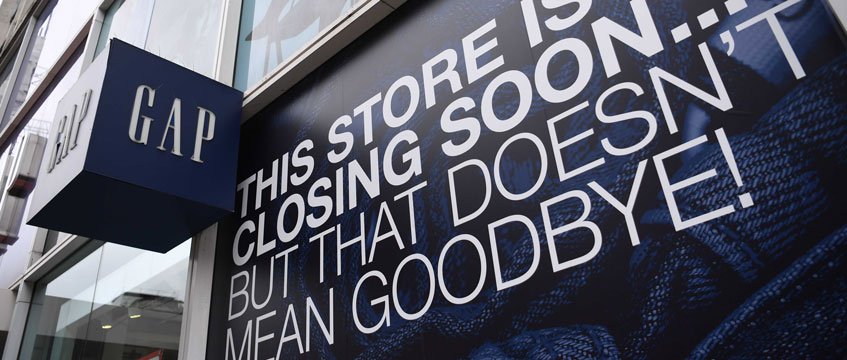The gaps left by Gap’s decision to close its 81 stores nearly a year ago are still prominent among the UK’s town centres and retail parks, but they are starting to be filled again by food and beverage and fashion occupiers, according to new research.
Findings from Carter Jonas for March 2022, exclusively shared with EG, showed that 22% of Gap’s stores have been relet, with around two more thought to be under offer.
Researchers said this fell below the average time a store spends on the market – close to 12 months – indicating that Gap may not have agreed lease surrenders with its landlords.
The bulk of the retailer’s circa 644,000 sq ft portfolio, mainly located across major town centres and out-of-town retail parks, closed in Q3 last year. The final store closure at the end of September marked the end of a 34-year physical presence, after the group’s first outlets opened in 1987.
Back in fashion
Food and beverage retailers accounted for 39% of relet Gap stores. Significant leasing deals included Wendy’s signing for a store in Brighton and Coppa Club’s expansion in Bath.
Tim Brooksbank, associate partner at Carter Jonas, said restaurateurs are seeing “good opportunities” to secure sites, given the relaxed rules on use classes. “Gap occupied prime high street locations – they’re all sizeable, prominent and have attractive features, and there’s scope to put in an open kitchen – so I think the A3 operators are making a beeline for those,” he said.
However, Brooksbank added that his team is starting to see more interest from A1 retailers.
Notably, fashion retailers represented a similar proportion (39%) of tenants moving into Gap stores. Researchers said this signalled ongoing confidence in bricks-and-mortar from some occupiers in the sector for the right locations.
Nearly all the relet shops have been taken up by chain operators, suggesting there is still confidence in the format. These include HMV, which is occupying two Gap stores, in Bath and Edinburgh.
Out-of-town lags behind
All of Gap’s out-of-town shopping centre locations have stayed empty. However, Brooksbank predicted that demand is “about six months away” from manifesting as deal activity, as more businesses gain confidence in the market.
Of the stores that have been relet, an 83% majority were in town centre locations, which make up 59% of the portfolio. Occupiers taking space have included Planet Organic, which moved into a store in Hampstead.
The remainder (17%) were at out-of-town retail parks, with the likes of discount retailer Oops taking a 6,000 sq ft store in West Bromwich.
North West success
None of Gap’s former stores in the East Midlands, the North East, Northern Ireland and Wales have been relet, the report found. Additionally, 92% of its floorspace in the West Midlands was still vacant, representing 10% of its national vacant square footage.
By contrast, three of its six stores in the North West were relet, two of which were in town centres.
Of the retailer’s London portfolio, which accounts for 31% of its total floorspace, 79% of its square footage remained empty. This amounted to 21% of the overall figure.
However, researchers were upbeat that take-up would improve in the coming months. Occupier demand is predicted to recover, particularly from independents and smaller chains, regardless of concerns about inflation, reduced consumer spending power and a short-term fall in confidence.
Brooksbank highlighted that it is important for owners of empty premises to “just get someone in there”, or risk letting unused properties fall into disrepair.
“We’ll try and get you as long a ‘term certain’ as we can, but if it means taking a hit on the rent, let’s share the pain with that retailer,” said Brooksbank. “That way, when rates are hopefully looked at again – which they absolutely need to be – we’ll start to see a bit of rental growth.”
To send feedback, e-mail pui-guan.man@eg.co.uk or tweet @PuiGuanM or @EGPropertyNews











